Algerian M’hajeb – Traditional Filled Pastry Recipe
Welcome to my kitchen, where today I’ll be sharing with you my recipe for Algerian M’hajeb – a traditional filled pastry that is a staple in Algerian cuisine. This dish is also known as mahjouba or samsa, depending on the region where it is made.
Growing up in Algiers, I have fond memories of this dish being served at family gatherings and special occasions. The aroma of the spices and the taste of the filling would fill the air, inviting everyone to gather around the table and enjoy this delicious treat.
Now, I want to share this recipe with you so that you can experience the same joy and warmth that comes with traditional Algerian dishes. Whether you’re a fan of vegan food or just looking to explore new flavors, this recipe is sure to hit the spot. So, let’s get started!
Why You’ll Love This Recipe
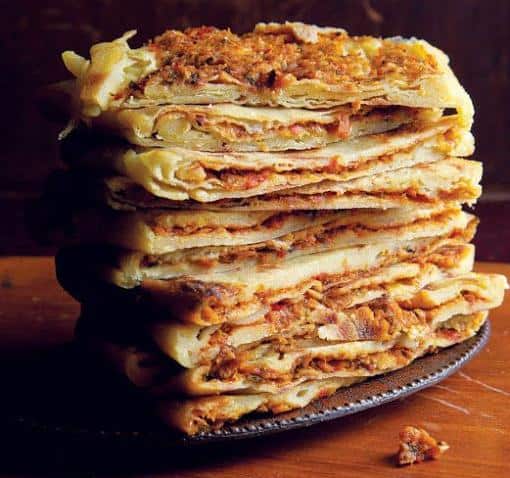
Are you ready to take your taste buds on a journey to Algeria? Look no further than this traditional Algerian M’hajeb recipe! This filled pastry dish is a staple in Algerian cuisine and is sure to impress with its unique blend of flavors and textures.
First of all, let’s talk about the pastry itself. The dough is made from a combination of plain flour, fine semolina, water, salt, and olive oil, resulting in a crispy yet tender base that perfectly complements the filling. Speaking of the filling, it’s made from a mixture of cooked onions, green peppers, tomato puree, and a blend of spices. This combination of savory flavors creates a delicious and satisfying meal that will leave you feeling truly satisfied.
Not only is this recipe delicious, but it’s also incredibly versatile. It’s vegan, making it a great option for those with dietary restrictions, and can be enjoyed as a main dish or as a snack. Plus, it’s a great way to explore traditional Algerian cuisine and introduce new flavors and techniques into your cooking repertoire.
In short, this traditional Algerian M’hajeb recipe is a must-try for anyone looking to expand their culinary horizons. Its unique blend of flavors and textures, versatility, and cultural significance make it a standout dish that you’ll be proud to serve to your family and friends. So why wait? Get ready to experience the deliciousness of Algerian cuisine with this amazing M’hajeb recipe!
Ingredient List
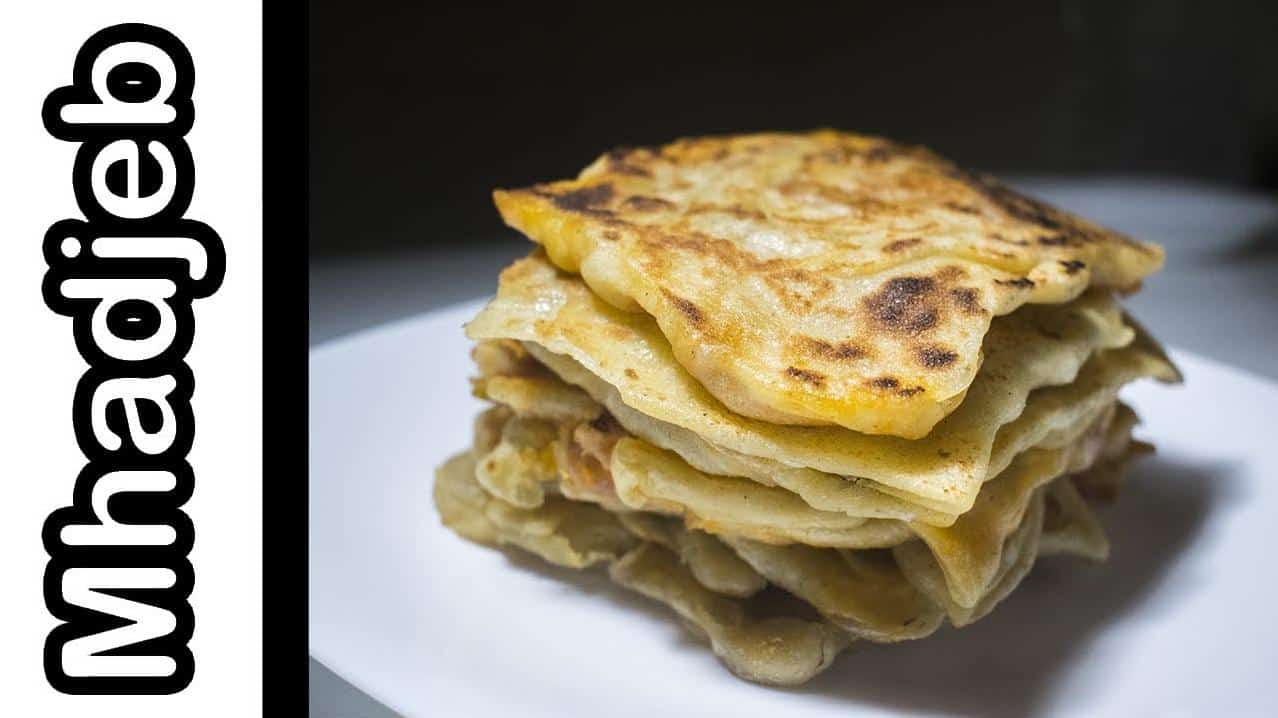
Before we dive into the recipe, let’s take a look at the ingredients we’ll need to make these delicious Algerian M’hajeb. Don’t worry, you won’t need to make a special trip to a specialty store – you can find everything you need at your local grocery store.
Here’s what you’ll need:
- Water (1 cup): We’ll need water to make the dough for the M’hajeb.
- Salt (1 tsp): A little salt will help bring out the flavors of the filling.
- Plain flour (2 cups): This is the base of our dough. Make sure to use plain flour.
- Fine semolina (1 cup): Semolina adds a nice texture to the dough.
- Olive oil (2 tbsp): This will help make the dough more pliable and add a nice flavor.
- Green peppers (2): We’ll use green peppers to add a little bit of heat and flavor to the filling.
- Tomato puree (1/4 cup): Tomato puree adds a rich, tomatoey flavor to the filling.
- Onions (2): Onions add a little bit of sweetness and depth of flavor to the filling.
That’s it! With these simple ingredients, we’ll be able to make delicious traditional filled pastries that are sure to impress.
The Recipe How-To
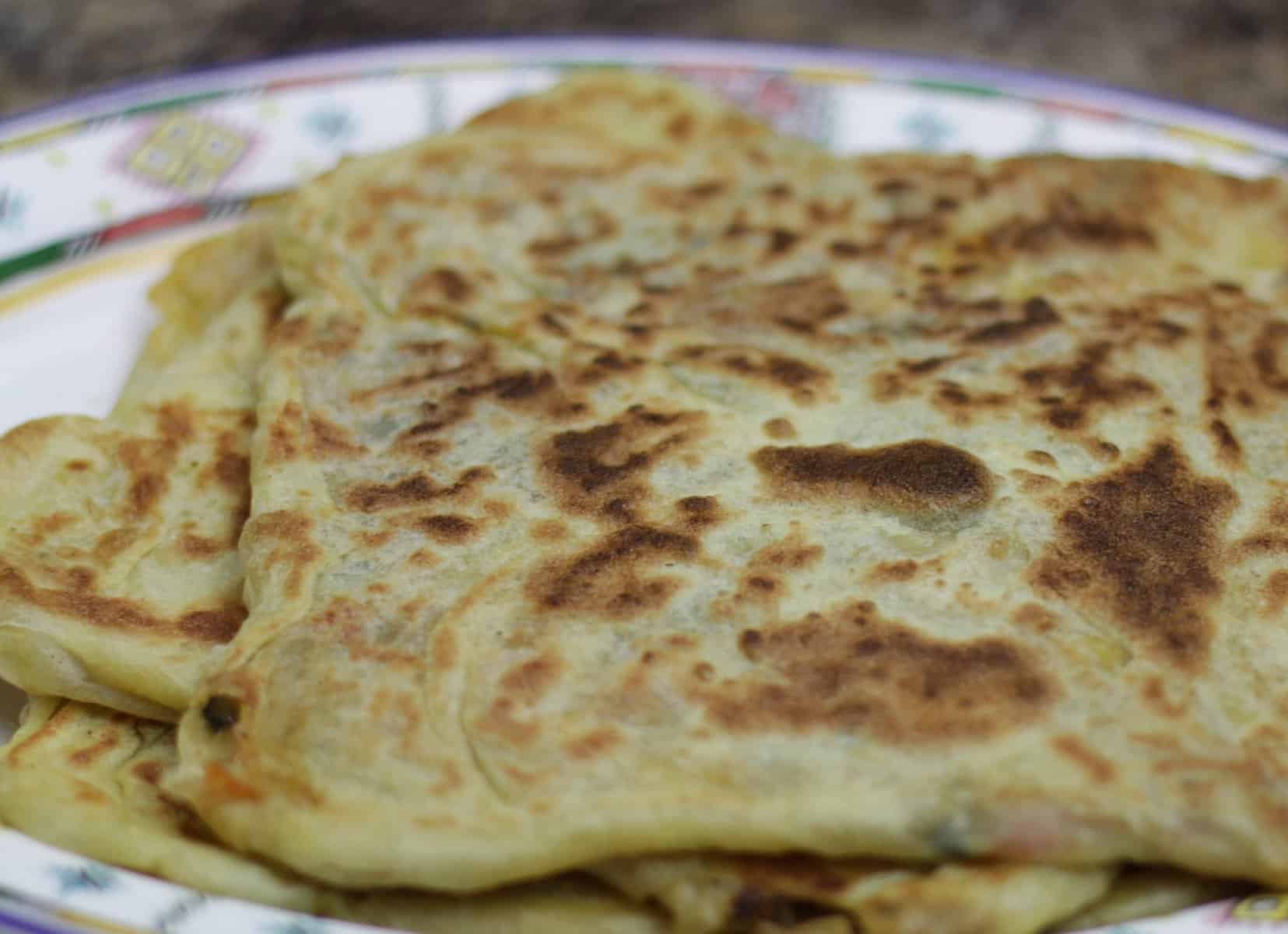
Now, let’s get to the exciting part, the how-to of this Algerian M’hajeb recipe. This recipe is straightforward and easy to follow. You don’t need any fancy equipment or skills to make this traditional filled pastry.
Ingredients:
- 2 cups of plain flour
- 1 cup of fine semolina
- 1 teaspoon of salt
- 1 1/2 cups of water
- 1/4 cup of olive oil
- 1 cup of diced green peppers
- 1 cup of tomato puree
- 1 cup of diced onions
Instructions:
- In a large mixing bowl, combine the plain flour, fine semolina, and salt. Mix well.
- Slowly pour in the water into the mixture, using your hands or a spoon to combine the ingredients until you have a smooth dough.
- Knead the dough for at least 10 minutes until it is elastic and doesn’t stick to your hands.
- Form the dough into a ball, cover it with a damp cloth, and let it rest for at least 30 minutes.
- Meanwhile, in a pan over medium heat, sauté the diced green peppers, tomato puree, and onions in olive oil until they are soft and cooked through. Season with salt and pepper to taste.
- Preheat a non-stick pan or griddle over medium-high heat.
- Divide the rested dough into 8 equal-sized balls.
- Roll each ball into a thin circle, around 8-10 inches in diameter.
- Spoon 2-3 tablespoons of the cooked vegetable mixture onto one half of the dough circle.
- Fold the other half of the dough over the filling and seal the edges by crimping them with a fork or your fingers.
- Place the M’hajeb onto the preheated pan and cook for 6-8 minutes on each side or until golden brown.
- Repeat the process until all the dough and filling are used up.
Notes:
- You can add or substitute the filling with any vegetables, meat or cheese of your choice.
- The M’hajeb can be served hot or cold, and it’s perfect for a quick lunch or snack.
- M’hajeb is often referred to as Mahjouba or samsa, and it’s a popular street food in Algeria.
- This recipe is vegan-friendly and perfect for those who are looking for traditional Algerian sweets or dishes.
Now that you know how to make this traditional Algerian filled pastry, it’s time to get cooking! Don’t be afraid to experiment with different fillings and flavors. This recipe is versatile and can be customized to your liking.
Substitutions and Variations
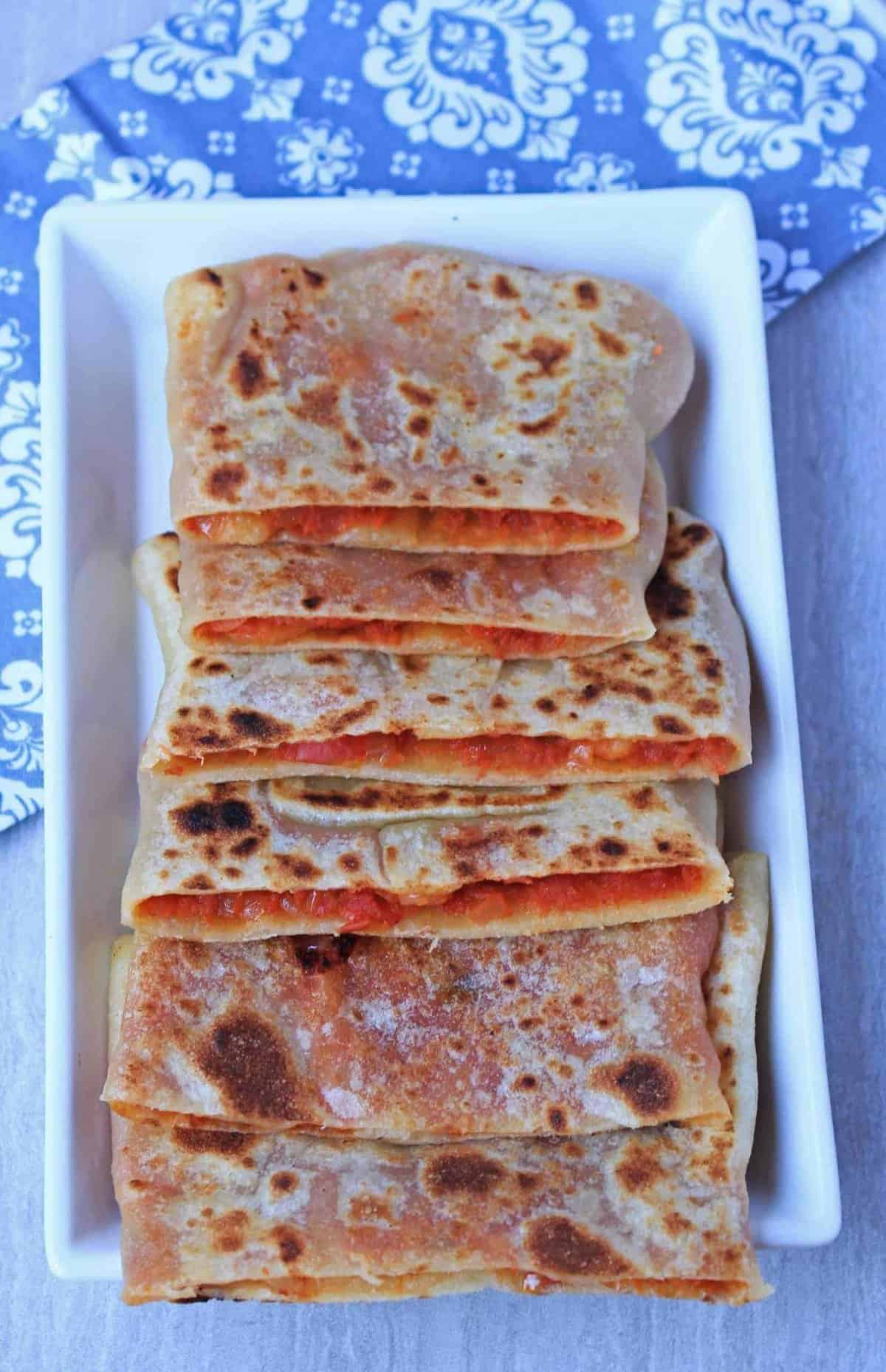
One of the great things about traditional Algerian cuisine is that it’s incredibly versatile. While the M’hajeb recipe is delicious as is, there are plenty of ways to customize it to suit your taste or dietary needs. Here are some substitutions and variations to consider:
– Vegan: To make this recipe vegan-friendly, simply omit the filling or replace it with a vegan option. Some delicious vegan fillings to try include sautéed mushrooms, bell peppers, or spinach.
– Gluten-free: While the dough for M’hajeb traditionally contains wheat flour and semolina, you can make a gluten-free version by using a combination of rice flour and chickpea flour instead. Keep in mind that the texture and taste may differ slightly from the original recipe.
– Filling options: The traditional filling for M’hajeb is a mixture of sautéed onions, green peppers, and tomato paste. However, you can get creative with your fillings! Some other tasty options include ground beef or lamb with spices, feta cheese and spinach, or even Nutella for a sweet twist.
– Shape: While M’hajeb is typically made into a triangular shape, you can experiment with different shapes and sizes. For example, you can make smaller, bite-sized versions for a party appetizer or shape them into rectangles for a more traditional Algerian bread called samsa.
– Spices: While the traditional recipe doesn’t call for many spices, you can add your own for extra flavor. Try adding a pinch of cumin, paprika, or coriander to the filling mixture for a subtle kick.
No matter how you choose to customize your M’hajeb, the end result is sure to be a delicious and satisfying dish that’s perfect for any occasion.
Serving and Pairing
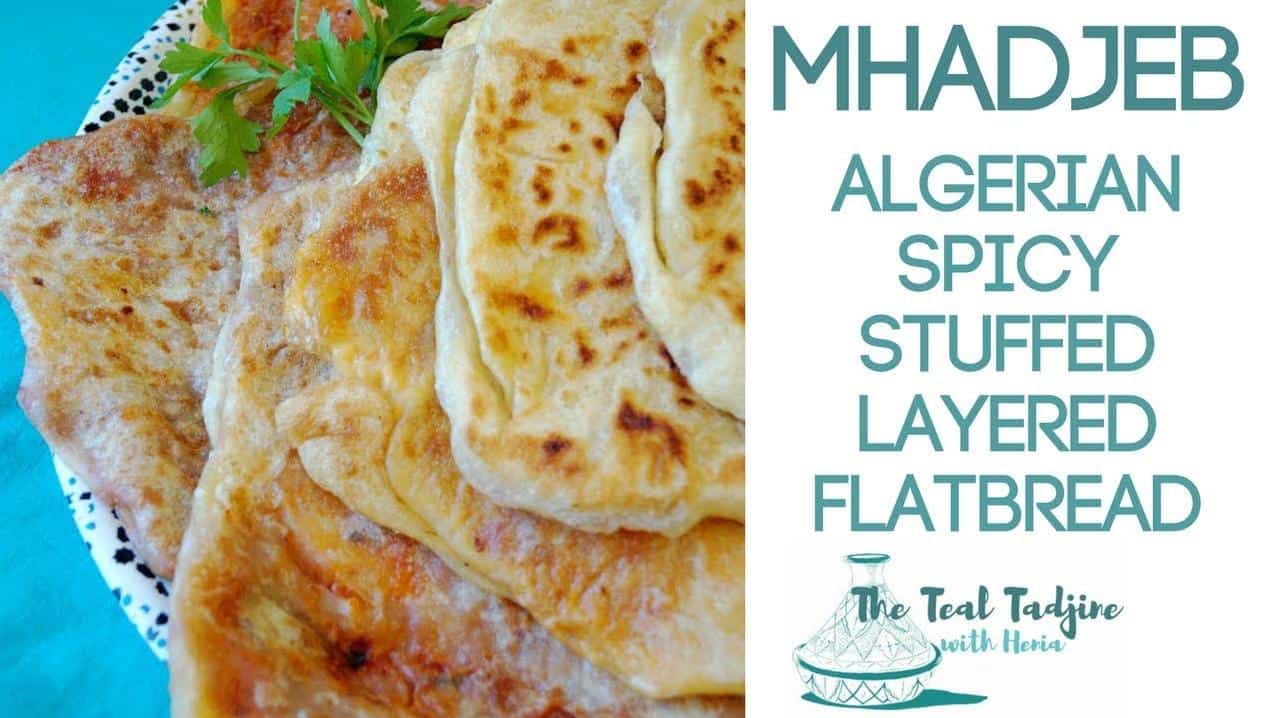
Algerian M’hajeb is a versatile dish that can be enjoyed in various ways. Traditionally, it is served hot and fresh, straight from the pan. Once cooked, the pastry can be cut into smaller pieces and served as an appetizer or snack. It can also be served as a main dish along with a side salad, such as a tomato and cucumber salad, or a traditional Algerian dish like couscous.
To add more flavor and texture to your M’hajeb, you can serve it with a variety of condiments and sauces, such as harissa, a spicy chili paste, or chermoula, a mixture of herbs, spices, and lemon juice. You can also add some freshness to the dish by serving it with a side of tzatziki or hummus.
If you are hosting a party or gathering, M’hajeb can be a delicious addition to your appetizer table. You can arrange the cut pieces on a platter and serve them with toothpicks for easy grabbing. Your guests will love the flaky pastry and flavorful filling.
M’hajeb is a great vegan option for those who are looking for plant-based dishes. It is also a popular street food in Algiers and a staple in Algerian cuisine. You can pair it with a cup of mint tea or almond milk for a complete experience of Algerian sweets and snacks.
Overall, M’hajeb is a delicious and satisfying dish that can be enjoyed in many different ways. Whether you are looking for a quick snack or a hearty meal, this traditional filled pastry will not disappoint.
Make-Ahead, Storing and Reheating
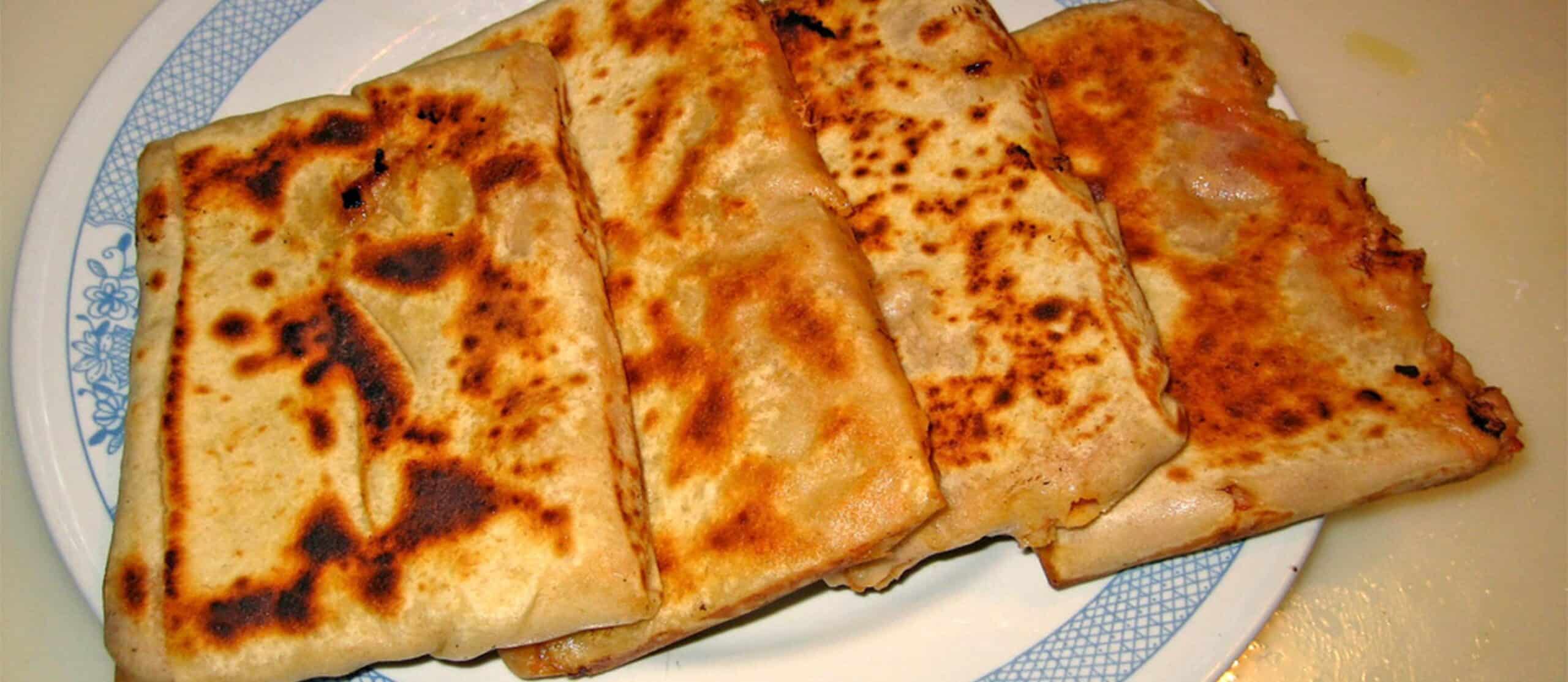
One of the great things about Algerian M’hajeb is that you can make it ahead of time and store it for later use. This makes it a great choice for meal prep or for hosting guests. To make ahead, simply follow the recipe instructions up until the point of cooking, then wrap the uncooked M’hajeb tightly in plastic wrap and store it in the refrigerator for up to two days.
When it comes time to cook, simply remove the M’hajeb from the refrigerator and let it sit at room temperature for 10-15 minutes to warm up slightly. Then, cook as directed in the recipe.
If you have leftovers, you can store them in an airtight container in the refrigerator for up to three days. To reheat, simply place the M’hajeb in a preheated oven at 350°F (180°C) for 5-10 minutes, or until heated through.
It’s worth noting that M’hajeb is best enjoyed fresh, so try to make only what you need for each meal. However, if you do have leftovers or want to make ahead, following these tips will ensure that your M’hajeb stays fresh and delicious.
Tips for Perfect Results

When making Algerian M’hajeb, it’s important to follow the recipe closely in order to get the perfect result. However, there are a few tips and tricks that can help ensure your M’hajeb turns out just right.
First and foremost, make sure your dough is well-kneaded. Kneading the dough for at least 10 minutes will help to develop the gluten in the flour, resulting in a more elastic dough that’s easier to work with. It will also help the pastry to puff up nicely when cooked.
Next, be sure to let the dough rest for at least 30 minutes before rolling it out. This will allow the gluten to relax, making the dough easier to stretch and roll without tearing.
When rolling out the dough, be sure to use a light touch and roll it out evenly. If the dough is too thin in some places and too thick in others, it will cook unevenly and may result in a tough, chewy pastry.
When filling the M’hajeb, be sure to use a generous amount of filling, but not so much that it spills out when cooking. Use a spoon to spread the filling evenly over the dough, leaving a small border around the edges to prevent spilling.
When cooking the M’hajeb, be sure to cook them over medium-high heat. If the heat is too low, the pastry will not puff up properly and may be soggy. If the heat is too high, the pastry may burn before it’s fully cooked.
Finally, serve the M’hajeb warm, straight from the pan. This will ensure that they’re at their best – crispy on the outside and tender on the inside.
By following these tips, you’ll be well on your way to making perfect Algerian M’hajeb every time.
Bottom Line
In conclusion, the Algerian M’hajeb is a traditional filled pastry that is loved by many for its unique taste and texture. This dish is a wonderful representation of Algerian cuisine, and it is a must-try for food enthusiasts who are looking to explore traditional dishes from around the world. With its vegan-friendly ingredients and simple preparation process, the M’hajeb is the perfect addition to any meal, whether it be breakfast, lunch or dinner.
Don’t be afraid to experiment with different fillings and variations to make this dish uniquely your own. The possibilities are endless, and the results are always delicious. So, why not give this recipe a try and experience the taste of Algeria in the comfort of your own home?
I hope that this recipe article has given you all the information you need to make the perfect M’hajeb. From the ingredient list to the tips for perfect results, I’ve tried to cover everything you need to know to make this dish a success. If you have any questions or comments, feel free to leave them in the FAQ section, and I’ll be more than happy to help you out.
Thank you for joining me on this culinary journey, and I hope that you enjoy making and eating the Algerian M’hajeb as much as I do. Bon appétit!
Algerian M’hajeb – Traditional Filled Pastry Recipe

M’hajeb are infamous in Algeria & Morocco – where they are also known as M’semmen. They are a fine pastry made of semolina & filled with a delicious mix of tomato, onion & sometimes peppers. M’hajeb keep well in the freezer when individually wrapped & any leftover pastry makes a lovely breakfast when served with honey. M’hajeb are very popular all year round but they are frantically devoured during Ramadan!
Filling
- 4 onions
- 2 tablespoons concentrated tomato puree
- 2 green peppers (the very large Algerian mildly hot peppers)
- 2 tablespoons olive oil
- salt & pepper
- 1 hot pepper (optional)
Pastry
- 500 g fine semolina
- 250 g plain flour
- salt
- water
- Filling:
- Slice the onions in fine rings. Slice the peppers into fine strips ( many people remove skin first) and fry together in a little olive oil until softened. (If using the hot pepper, de-skin then puree, add to the onions & peppers.) Add the puree, salt and pepper and cook covered, for approx 5 minutes or until soft and well flavoured. Set aside to cool.
- Pastry:
- *To make the pastry, it’s easiest if you have a mixer with a dough hook or a bread maker set on the dough setting.*.
- Mix the semolina and the flour in a mixer of place in the bread machine. Make a hollow in the centre, add a little salt and enough water to bring to a stiff dough. Knead well. Add a little more water, a bit at a time until the dough is finally a soft elastic consistency – this is usually around 8-10 minutes.
- Wehen the dough it nice and elastic, pull of pieces and roll into golf balls. The secret is to have EVERYTHING WELL OILED — Oil your hands, the work surface and the m’rie or large skillet / chappati pan.
- Take a golf ball at a time and gently stretch out as thin as you can. It’s easiest to do this on a well oiled work surface. If uyou get a few little holes, don’t worry – you can patch them up and nobody will mind!
- Place a spoonful of filling in the centre and fold the edges in one at a time (left, right, top, bottom), to form a rough square shaped parcel. Fry until golden on both sides – you have to be very attentive here or they will burn!
- Any dough left over can be cooked plain and served with honey (great for suhor!).
[custom-related-posts title=”Recommended Recipes Just For You” none_text=”None found” order_by=”date” order=”ASC”]
